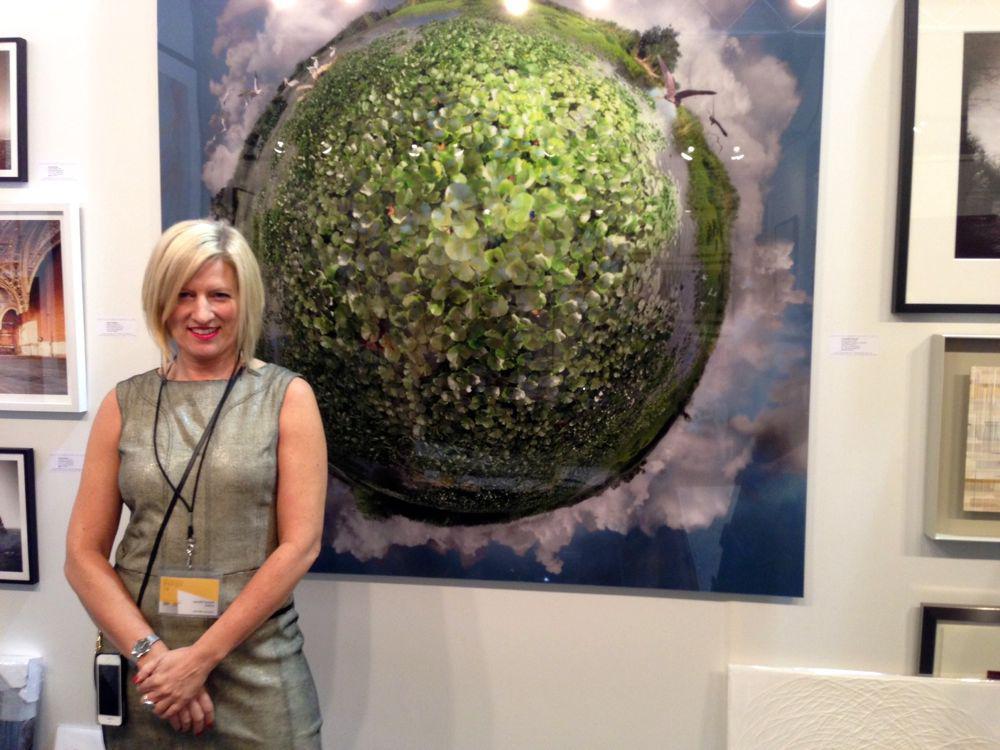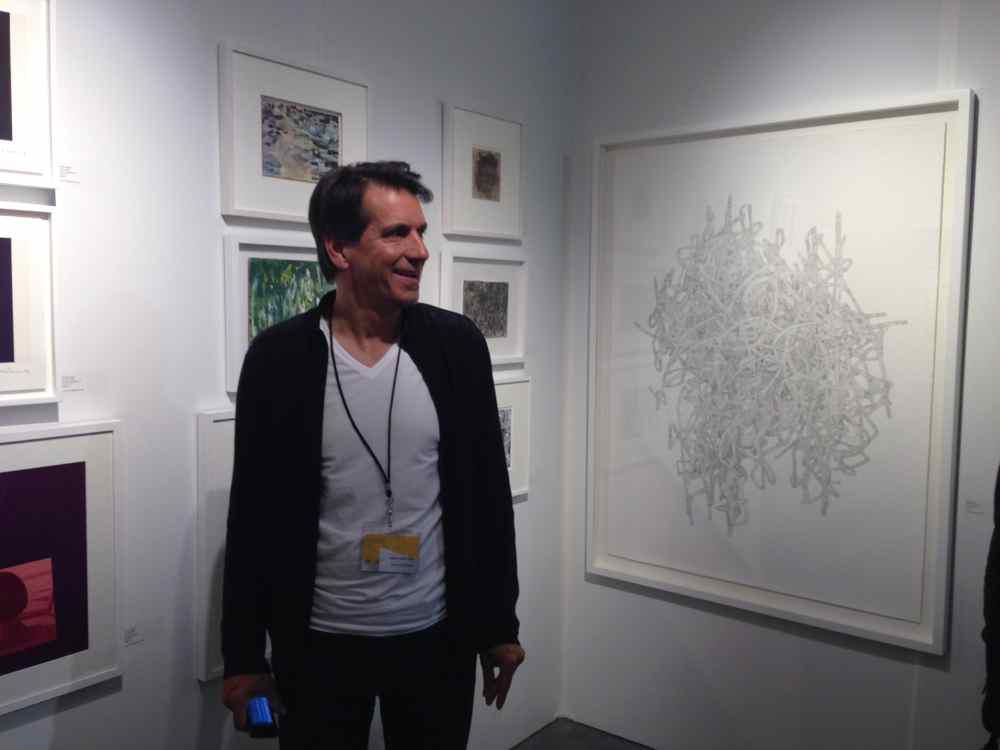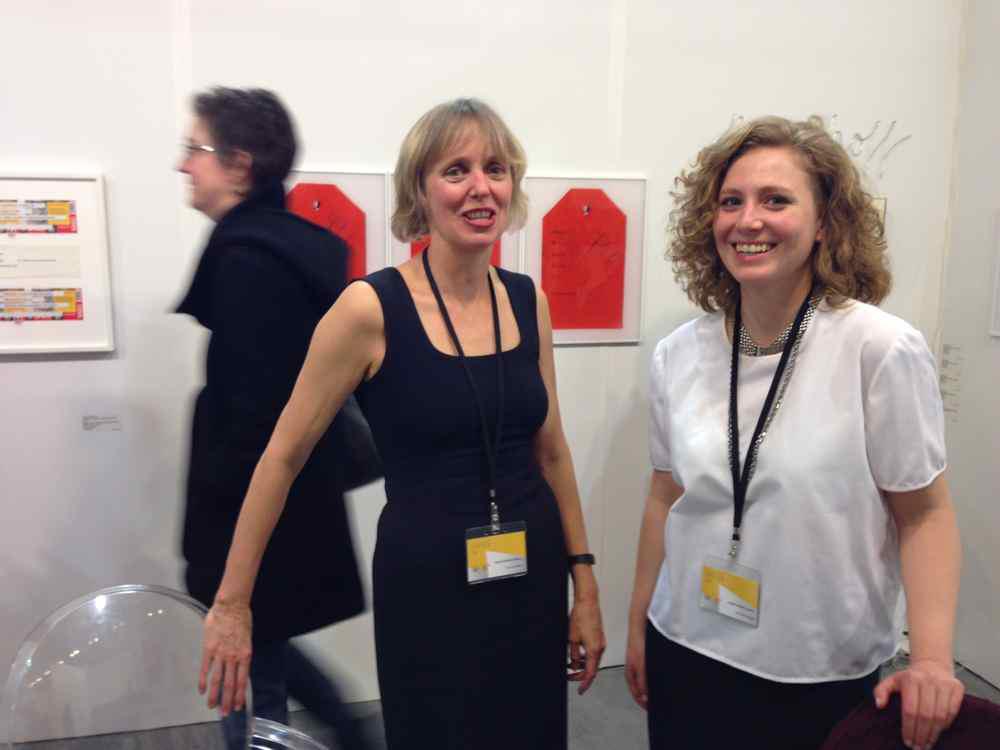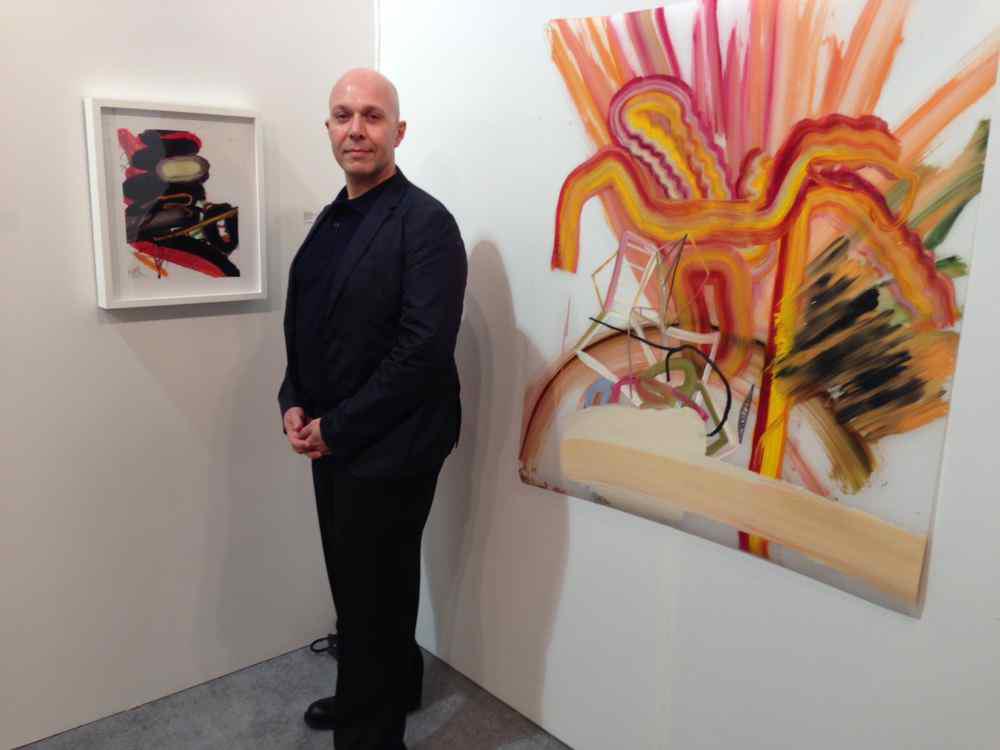There are 44 dealers at Papier14—the most ever since the fair started in 2007 with roughly 15 galleries on the roster—and while the majority remain from Montreal, there are also galleries this year from Vancouver, Toronto, Edmonton, Calgary, Ottawa and Quebec City. Here, four dealers of varied experiences and locales share their thoughts on the fair.

The Newbie: Jennifer Kostuik of Jennifer Kostuik Gallery, Vancouver (Booth 311)
Jennifer Kostuik Gallery was founded in 1997 and represents established and emerging artists from Canada, the US, Japan and Mexico. This is her first year at Papier, and she has brought works by David Burdeny, Dianne Bos and Curtis Cutshaw, among other artists.
Q: Vancouver is more than 3,000 kilometres from Montreal. Why come all this way to do Papier 14?
A: I want the Montreal art-buying market to know my gallery exists, and it is not very expensive compared to other art fairs.
Q: You’re new to Papier. What clinched your participation in it?
A: I like the format of the fair focusing on one medium. Also, a director approached me and personally invited me to join.
Q: What other fairs do you do? What results have you gotten from them? And what do you hope to get from this fair?
A: I have done Art Miami for several years. I used to do art fairs in NYC. I have done the Palm Springs art fair twice, the San Francisco art fair twice, Los Angeles once and the Toronto art fair three times.
Each fair varies, but my most successful art fair overall is Art Miami and the New York art fairs of the past.
At Papier, I hope to have financial success and make new and ongoing clients for my gallery and artists.
So far, [in the first couple of days], I have sold small things, so I’m hoping that—as with many fairs—the big stuff will happen at the end.
Q: In the past, we’ve heard that it can be hard to sell non-Quebec art to Quebec collectors. How do you intend to deal with this phenomenon at Papier 14? Also, are you bilingual? If not, how do you plan to deal with the language factor?
A: I am not bilingual, but have assistance from volunteers at the fair. Art is visual and money is numbers, so if we cannot speak the same language, it will not hinder a sale.
So far, I have found it very welcoming. I hung the booth salon-style because I wanted to introduce many different artists. Like for [Australian artist] Catherine Nelson—no one has seen her work in Canada before, so I brought a large piece.
Q: What else are you hoping to see or do while in Montreal for the fair (if anything)?
Usually I contact clients, but I only had one appointment with an art consultant in the week going into the fair.
Otherwise, eat great food and meet with some of my gallery artists that do not reside in Vancouver.

The Veteran: François Babineau of Galerie Simon Blais (Booth 202)
François Babineau has worked at Galerie Simon Blais since 1989, the year it was founded. He and the gallery were involved in creating the first iteration of Papier in 2007, and Babineau was on this year’s fair committee as well. This year, the GSB booth includes work by Marc Séguin, Alexis Lavoie and Julie Ouellet, among other artists.
Q: You were at the original 2007 edition of Papier. What was it like then, and what were your hopes for it?
A: Well, there had been quite a few tries to create an art fair in Montreal before that. There was an event held during the Salon du Livre at Place Bonaventure. We had quite a bit of subsidy for that at first, but when the subsidy went, the fair went too.
We tried doing fairs in hotel suites for a while, and we also tried in Old Montreal. Neither worked.
So we were a bit nervous to go ahead with the first edition of Papier, which we did in the entrance hall of Westmount Square. But we knew we would do well with this art fair because they were renting the space fairly cheap and there was room for many galleries.
When we did the third edition, it was in the Black Watch Armoury. And from there it started getting bigger and bigger every year.
Initially, we were hoping to get some people through, and were hoping that it would be a commercial success for the exhibitors—and it was right from the beginning, at least for us. Since the booths were fairly affordable, we didn’t need to make that many sales to be profitable.
So I think we’re through the worst, and this year, I think, we will get quite a few people through—10,000 or 11,000 at least.
Q: How have sales or visitor interests at Papier changed during all the years you have exhibited at the fair?
A: Well, it’s an art fair that is free to attend, so you get all kinds of collectors that come during the weekend.
The idea is to democratize contemporary art. For a lot of people it’s their first contact with contemporary art, ever, and they’re sort of amazed to see that there are many things here they could afford and live with.
But there are also serious collectors and serious collections—and we [on the fair’s organizing committee] get commitments from Loto-Quebec and Hydro Quebec and others so that we know there will be some guaranteed money spent at the art fair overall.
Overall, Montreal is a different market. It’s not a rich city, like Toronto. But there is interest and a lot of good works to be seen.
Q: What other fairs do you do? What results have you gotten from them?
A: We haven’t done very many. I know that in Europe, it [doing lots of fairs] is a model that is very common, possibly because the gallery spaces are often small and they can get to 4 or 5 fairs easily, in just a few hundred kilometres. Here, it’s a bit more complicated.
But we are moving to do more fairs. We are applying for Untitled this year in Miami, and we did Art Toronto up until 2012. Now, we are looking to Chicago or New York or Europe too.
Q: We’ve heard that it can be challenging for some non-Quebec galleries to make a go of it at Papier given the Quebec-centric interests of some collectors here. What is your response to this issue? What would you recommend for non-Quebec galleries to do in visiting the fair?
A: I think that at any art fair, anywhere, you have to exhibit a few times before sales start to happen. Your first year, visitors say “Oh, you look like a serious gallery, but…” The second year, they take you more seriously, and the third year is when it might happen.
Also, it [regionally focused collecting] doesn’t just happen in Quebec. In the States, it can be much easier to sell American artists than Canadian artists or Spanish artists. It happens at every fair: people go with what they know.
So, again, when you have been there two or three times and they see that you are still doing well and working with other galleries in the world, there is a certain confidence that takes place.
Q: How would you like Papier to improve, grow or change in future?
A: Instead of growing big, we want to grow better. We want to keep galleries coming from all across Canada, so sales is an important issue—we are always thinking of ways to help those galleries.
In future, we’d also like to have galleries from different countries; New York is not far from here. We’d like to make it more than a Canadian art fair.

The Returnee: Susan Hobbs of Susan Hobbs Gallery, Toronto (Booth 302)
Susan Hobbs Gallery opened in 1993, and represents a range of Canadian and international artists out of its two-storey gallery on Tecumseth Street in Toronto. This year for Papier, she and Ella McGeough have brought work by a variety of artists, including Ian Carr-Harris, Arnaud Maggs and Didier Courbot.
Q: This isn’t your first year at Papier. How long have you been coming to the fair? Why have you returned?
A: I first did Papier 11, so this will be my fourth year. I like the scope and size of the fair, I like introducing or showing gallery artists to different audiences, and the sales I have made would not have happened outside the fair.
The size, material restraints, equal space to all exhibitors helps with a cohesive-looking fair. I find that fairs organized by dealers/gallery associations excel at ensuring the needs of dealers are met.
Q: What other fairs do you do? What results have you gotten from them?
A: I used to do Art Forum Berlin and The Armory Show. I am not actively looking to do fairs anymore as they don’t meet my needs or desires.
Q: We’ve heard that it can be challenging for some non-Quebec galleries to make a go of it at Papier given the Quebec-centric interests of some local collectors. What is your response to this issue? What would you recommend for non-Quebec galleries to do in visiting the fair?
A: I think the Quebec-centric interests are more with the corporate collectors than private collectors.
That said, I have met and sold to a number of corporate art consultants and not that many private collectors. I have always included artists in my booth that have some connection to Quebec, while remaining true to my programming.
I don’t know that I would have any recommendations for other galleries—we each need to figure out who our audience is—and how we want to present to them (my experiences aren’t transferrable to someone else).
Q: Are you bilingual? How do you deal with language issues when exhibiting at Papier?
A: Yes, but not English/French. In the past, I have hired an assistant, based in Montreal, throughout the fair.
This year, Ella McGeough and I are attempting to do it without much French between us. I liked being able to provide information in French, but it also cut me out of a number of discussions.
It will be interesting to see how it works this year.
Q: How would you like Papier to improve, grow or change in future?
A: Well, this year I can see that the quality is improving. The booths used to just be six feet deep, and now they’re eight, so that’s quite a difference. There wasn’t an area for talks last year, it was sort of in the cafe, so the fact they’ve delegated a particular area for that is also really great.
It’s a good fair, and overall, I will be better able to answer this question at the end of April.
Q: What else (if anything) are you hoping to do in Montreal while you are in town for the fair?
A: Eat well. It is difficult to see many shows as the fair hours tend to be gallery hours.

The Voyager: Patrick Mikhail of Patrick Mikhail Gallery, Ottawa (Booth 307)
Patrick Mikhail opened his gallery in Ottawa in 2006, but finds that many of his main clients live in Montreal, which is just two hours’ drive away. Accordingly, in September 2014, Mikhail is planning to open a gallery space in Montreal as well. Mikhail was on the committee for Papier14, and artists he is featuring at his booth include Jennifer Lefort, Colin Muir Dorward and Thomas Kneubühler.
Q: This isn’t your first year at Papier. How long have you been coming to the fair? Why have you returned?
A: We have been doing Papier since 2012, so it’s our third year at the fair. Papier is totally unique. It’s a commercial art fair that functions more like a cultural event—with a big heart and a brain to match. Everything about the fair seems smart and sincere—from the intimate size, to the line-up of galleries, to the quality of collectors.
I also feel that, because it’s organized by galleries for galleries, there’s a stronger esprit de corps among the dealers. There’s less anxiety. We’ve also had strong and consistent sales over the past few years so that has motivated us to return. And of course, Montreal’s charm is pretty hard to resist.
Q: What other fairs do you do? What results have you gotten from them?
After we first launched the gallery, we attended five editions of Art Toronto from 2007 to 2012.
Since then, we have been expanding the gallery’s scope, building our brand, and bringing our artists to an international market to reach collectors and curators that we wouldn’t have access to in Canada.
We have done VOLTA New York 2013 and VOLTA New York 2014. In June we’re travelling to Basel, Switzerland, to participate in VOLTA 10 Basel.
Since our first edition of Volta New York last year, the results have been substantial both in economic and creative terms. We are discovering a whole new world—and it’s discovering us. We have racked up a list of loyal clients from New York, London, Buenos Aires, Rio de Janeiro, Los Angeles, Zurich and beyond.
The international fairs also provide us with an incredible opportunity to learn and collect useful information from every single person we meet along the way—information that we put to good use all year long. It’s sharpened our eye. Expanded our taste. Helped us meet new artists. But most importantly, I think it’s provided a huge boost to our confidence.
Q: We’ve heard that it can be challenging for some non-Quebec galleries to make a go of it at Papier given the Quebec-centric interests of some local collectors. What is your response to this issue? What would you recommend for non-Quebec galleries to do in visiting the fair?
A: From my experience, I’ve learned that the exact opposite is true.
From the very beginning, I found the Quebec public to be extremely engaged and interested in complex ideas and concepts. They are curious about every detail. There’s a real appetite to learn about what’s happening outside Quebec, and an appreciation for the galleries making the trip to Montreal to exhibit. There are works and ideas that we wouldn’t dream of presenting in other parts of Canada—but in Montreal they take the time to investigate and discover.
The serious, accomplished collectors are quite savvy and knowledgeable. Quebec is not a vacuum. Most of the collectors I’ve worked with—and met at Papier—have a national and international perspective and are keenly aware of what’s happening across the country and around the world. These collectors are taking their time to educate themselves and are building collections that transcend region, culture, identity and politics.
For any gallery participating in Papier for the first time, I would say bring your best work, be true to yourself, don’t second-guess your artist roster, and don’t try to bring work that you think will resonate with the Quebec market. They are interested in good work. Period.
Q: Are you bilingual? How do you deal with language issues when exhibiting at Papier?
A: Before I attended our first edition of Papier in 2012, I remember being a little nervous about the language issues and dealing with the Montreal public in French. I’m about 80 percent bilingual but was still concerned about speaking perfect French in a business or cultural context.
That [nervousness] lasted about five minutes. People have been exceptionally accommodating. I always make an effort to start each conversation in French and people really appreciate the effort. I simply try my best to communicate and don’t worry about whether it’s perfect. If I’m really stuck, there always seems to be somebody close by willing to translate.
Q: How would you like Papier to improve, grow or change in future?
A: Even in the few years that I’ve been participating, I’ve noticed significant changes in the way Papier is organized. The presentation and fair layout is more polished; the non-commercial activities surrounding the fair are stronger and more tightly curated; and the fair’s cultural impact is being felt both inside and outside Quebec.
I’m especially pleased about the gallery line-up this year—with new first-class galleries coming from Toronto and Western Canada. My hope is that Papier will continue to move in this direction and grow to include more galleries from across Canada and the U.S.
I’m also hoping that the fair will continue to attract more corporate and private collectors travelling to Montreal from around the world to get a “snapshot” of the state of Canadian contemporary art each spring—and purchase works for their collections. It’s important that the critical mass that’s developing around the fair be supported and encouraged.
It would be nice if the fair developed an international identity and became the central focus of an entire week of activities and events—much in the way that New York’s Armory Show is the anchor for Armory Arts Week.
As Papier continues to grow, however, the trick will be to maintain the one characteristic about the fair that everyone seems to love—its intimacy.
Q: What else (if anything) are you hoping to do in Montreal while you are in town for the fair?
A: I have to admit, I’m looking forward to the parties and seeing friends and other gallerists. Other than that, Papier 14 is the main attraction.
These interviews, conducted by email, phone and in person, have been edited and condensed. To read more of our daily posts about Papier14, visit canadianart.ca/papier14.








